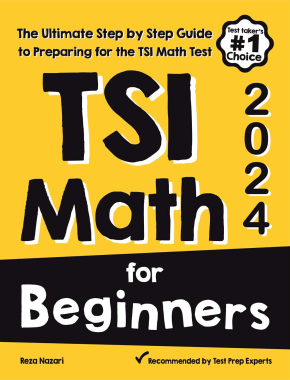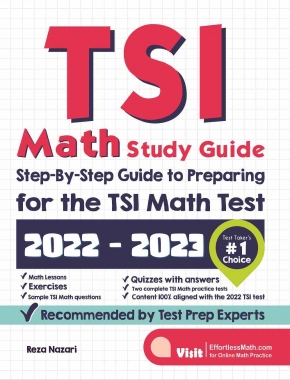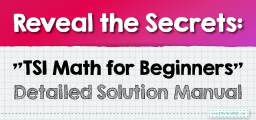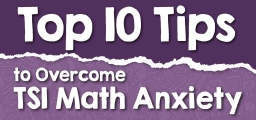What Kind of Math Is on the TSI Test?

The TSI (The Texas Success Initiative Assessment) test is used to determine the level of readiness of incoming students for college coursework. All incoming students of the Texas college are required to take the TSI test unless they are exempted under certain conditions. Student scores on this test indicate whether the student needs remedial classes or not.
The TSI test is an untimed computer-adaptive test with multiple-choice questions. Upon completion of the test, the student will receive a score and information about their skill level immediately.
The TSI test consists of three parts: math, reading, and writing.
The math part of this test consists of 20 multiple-choice questions. In this section, students are tested on four main topics:
- Elementary Algebra & Functions
- Intermediate Algebra & Functions
- Geometry & Measurement
- Data Analysis, Statistics, & Probability
The Absolute Best Book to Ace the TSI Math Test
Algebra and Functions
In the algebra section, test takers’ knowledge is tested at both the Elementary and intermediate levels to determine how well students can solve various algebraic equations. In the Elementary algebraic expressions and functions section, test takers are asked to solve simple equations and combine or simplify algebraic expressions. For Intermediate algebra and functions, test takers should also know what a quadratic equation is and how it can be solved. In this section, it is also important to know how to simplify the square roots and how to use the quadratic formula to solve problems. There are also questions about rational and exponential expressions, functions, and radicals in the Intermediate algebra and functions section.
Geometry and Measurement
The geometry & Measurement section measures test takers’ understanding of the geometric area, symmetry, and 3D shapes. In this section, test takers must prepare to answer questions such as missing measurements of rectangles, triangles, and circles. The questions of this section also measure the knowledge of the test takers about solid figures and 3D figures and geometric modeling for computer applications.
Data Analysis, Statistics, and Probability
In the Data Analysis, Statistics, & Probability section students’ ability is tested to work with data sets, probabilities, and statistics. How to interpret table and chart information is very important in this part. This section also includes questions about the mean, median, and other topics related to statistics and probabilities.
| math sections | topics | Number of questions | |
| #1 | Algebra and Functions | Fractions problems, Mixed Numbers problems, Decimals problems, Factoring Numbers, Greatest Common Factor, Least Common Multiple, Real Numbers and Integers, Proportions, Ratios, and Percent, Algebraic Expressions, Equations and Inequalities, Linear Functions, Exponents and Radicals, Polynomials, Functions | 15 |
| #2 | Geometry and Measurement | Pythagorean Theorem, Triangles, Polygons, Trapezoids, Circles, Cubes, Rectangular, Prism, Cylinder | 2 |
| #3 | Data Analysis, Statistics, and Probability | Mean, Median, Mode, and Range, Histograms, Pie Graph, Probability Problems, Combinations and Permutations | 3 |
Best TSI Math Prep Resource for 2022
Complete List of TSI Math Topics
Fractions and Decimals
- Simplifying Fractions
- Adding and Subtracting Fractions
- Multiplying and Dividing Fractions
- Adding Mixed Numbers
- Subtracting Mixed Numbers
- Multiplying Mixed Numbers
- Dividing Mixed Numbers
- Adding and Subtracting Decimals
- Multiplying and Dividing Decimals
- Comparing Decimals
- Rounding Decimals
- Factoring Numbers
- Greatest Common Factor
- Least Common Multiple
Real Numbers and Integers
- Adding and Subtracting Integers
- Multiplying and Dividing Integers
- Order of Operations
- Ordering Integers and Numbers
- Integers and Absolute Value
Proportions, Ratios, and Percent
- Simplifying Ratios
- Proportional Ratios
- Similarity and Ratios
- Percentage Calculations
- Percent Problems
- Discount, Tax and Tip
- Percent of Increase and Decrease
- Simple Interest
Algebraic Expressions
- Simplifying Variable Expressions
- Simplifying Polynomial Expressions
- Translate Phrases into an Algebraic Statement
- The Distributive Property
- Evaluating One Variable Expressions
- Evaluating Two Variables Expressions
- Combining like Terms
Equations and Inequalities
- One-Step Equations
- Multi-Step Equations
- Graphing Single–Variable Inequalities
- One-Step Inequalities
- Multi-Step Inequalities
- Systems of Equations
Linear Functions
- Finding Slope
- Graphing Lines Using Standard Form
- Graphing Lines Using Slope-Intercept Form
- Writing Linear Equations
- Graphing Linear Inequalities
- Finding Midpoint
- Finding Distance of Two Points
Exponents and Radicals
- Multiplication Property of Exponents
- Division Property of Exponents
- Zero and Negative Exponents
- Powers of Products and Quotients
- Negative Exponents and Negative Bases
- Scientific Notation
- Radicals
Polynomials
- Writing Polynomials in Standard Form
- Simplifying Polynomials
- Adding and Subtracting Polynomials
- Multiplying Monomials
- Multiplying and Dividing Monomials
- Multiplying a Polynomial and a Monomial
- Multiplying Binomials
- Factoring Trinomials
- Operations with Polynomials
Geometry and Solid Figures
Statistics and Probability
Functions
- Function Notation
- Adding and Subtracting Functions
- Multiplying and Dividing Functions
- Composition of Functions
FAQs:
Is the TSI math test hard?
The difficulty of the TSI math test questions depends on the test taker. Because the TSI is a computer-adaptive test, the next question will be more difficult if the test taker answers the question correctly. However, the more difficult questions are answered, the higher the possible score will be.
How do I study for the TSI Math?
How you prepare for the TSI math test is very important. You can use good prep books to prepare well for the TSI math test. You can also use online practice tests for further practice after studying the TSI exam courses.
Can I bring a calculator to the test?
Not. Test takers are not allowed to bring calculators and other unnecessary devices. In addition, there is a pop-up calculator on the screen for some questions.
How many questions can you miss on the math TSI to pass?
In TSI math you will need a minimum score of 350, which means you can miss between 1 and 3 questions.
The Best Book to Ace the TSI Math Test
More from Effortless Math for TSI Test …
Do not know much about TSI math test tips and strategies?
Just take a look at the Top 10 TSI Math Test-taking Tips!
Want to get acquainted with the 10 most common questions of the TSI test?
Then take a few minutes to read the 10 Most Common TSI Math Questions!
Have you heard that the full-length practice test helps you succeed in the TSI math test and you need one?
We have met your need !: Full-Length TSI Math Practice Test
The Perfect Prep Books for the TSI Math Test
Have any questions about the TSI Test?
Write your questions about the TSI or any other topics below and we’ll reply!
Related to This Article
More math articles
- The Ultimate Algebra 2 Course
- FREE Pre-Algebra Math Practice Test
- 10 Most Common 6th Grade SBAC Math Questions
- Top 10 PERT Math Prep Books (Our 2023 Favorite Picks)
- How to Compare Linear Functions Graphs and Equations
- How to Prepare for the TABE Math Test?
- 8th Grade NDSA Math Worksheets: FREE & Printable
- PSAT Math Formulas
- 10 Most Common 7th Grade PARCC Math Questions
- Best Touchscreen Monitors for Teaching at Home


















What people say about "What Kind of Math Is on the TSI Test? - Effortless Math: We Help Students Learn to LOVE Mathematics"?
No one replied yet.